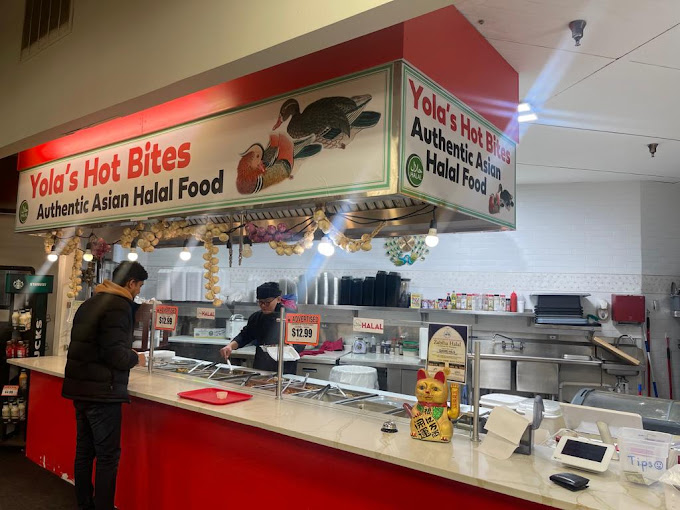Savor Genuine Asian Cuisine With a Pan-Asian Twist for a Culinary Experience
Beginning on a cooking journey via authentic Oriental cuisine, enhanced with a Pan-Asian twist, uses an unique opportunity to explore the rich tapestry of tastes that specify the area's varied cooking practices. As you contemplate these enticing meals, think about the social narratives and historic impacts that shape them, each bite supplying a tale waiting to be found. pan asian dining Islamabad.

Checking Out Pan-Asian Flavors
In the world of global gastronomy, Pan-Asian food sticks out for its amazing variety and the harmonious interaction of tastes from various Eastern cultures. This culinary technique commemorates the distinct active ingredients and rich traditions discovered across the continent, creating a tapestry of preferences that is both interesting and enjoyable. Secret to Pan-Asian food is its capacity to balance different flavors-- pleasant, salty, spicy, and sour-- while highlighting the quality and high quality of each component.
From the umami-rich soy sauce of Japan to the intense chili peppers of Thailand, Pan-Asian cuisine provides an extensive palette of tastes. These aspects are commonly incorporated in creative methods, enhancing dishes with layers of complexity. For circumstances, making use of fragrant natural herbs such as lemongrass and cilantro, usual in Vietnamese and Thai food, adds a rejuvenating brightness to recipes, while the consolidation of coconut milk delivers a velvety, abundant structure.
The emphasis on fresh fruit and vegetables and aromatic seasonings makes sure that each meal is not just a feast for the palate yet likewise for the detects. Pan-Asian food welcomes diners to get started on a cooking journey, exploring the large and varied landscapes of Eastern gastronomy with every bite.
Fusion Recipes to Attempt
While Pan-Asian cuisine is celebrated for its standard tastes, the modern culinary landscape is increasingly welcoming combination recipes that mix these traditional aspects with influences from other regions. This innovative approach not only honors the abundant heritage of Eastern cookeries yet also introduces unique taste experiences that interest contemporary tastes buds.
A prime example of such a combination dish is the Korean-Mexican taco, where marinated bulgogi beef is covered in a warm tortilla, covered with kimchi and a hot gochujang-infused salsa. This mix weds the strong, savory flavors of Korea with the lively, fresh components of Mexican cuisine. Likewise, sushi burritos have acquired appeal, joining together the delicate creativity of Japanese sushi with the passionate, hand-held ease of a burrito, commonly featuring combination ingredients like tempura shrimp and avocado with a drizzle of wasabi mayo.
An additional noteworthy meal is Thai curry ramen, which instills the creamy, fragrant seasonings of Thai curry right into the comforting broth of typical Japanese ramen, creating a harmonious blend that entices the senses. These fusion recipes extend beyond plain uniqueness; they represent a cooking dialogue between societies, urging expedition and advancement in the globe of Pan-Asian food.
Important Components and Spices
To genuinely appreciate Pan-Asian cuisine, one need to recognize the vital active ingredients and spices that form its foundation. This diverse culinary style attracts from an abundant tapestry of Oriental practices, using an unified blend of textures and tastes. Trick active ingredients include soy sauce, fish sauce, and oyster sauce, which pass on a mouthwatering umami depth necessary to Oriental meals. Complementary to these are rice vinegar and mirin, lending a delicate level of acidity and sweetness.
Fragrant elements are essential, with ginger, garlic, and lemongrass being common throughout various Pan-Asian dishes. These components provide a fragrant base that enhances the intricacy of flavors. Seasonings such as star anise, cardamom, and cinnamon introduce heat and character, resembling influences from regions like China and India.

Food Preparation Strategies and Tips
Grasping the art of Pan-Asian food requires experience with its unique food preparation strategies, each adding to the dynamic tapestry of tastes this cooking tradition is commemorated for. Central to these approaches is the stir-fry, a quick food preparation technique that maintains the dietary honesty and vivid colors of components. Utilizing a wok, the stir-fry technique permits also warmth distribution, necessary for attaining the particular structure and taste balance of Pan-Asian meals.
One more fundamental strategy is steaming, especially prevalent in Chinese food. This mild technique preserves the all-natural flavors and nutrients of components, making it ideal for seafood and vegetables. Dumplings, a beloved staple, frequently take advantage of Look At This steaming, leading to soft, delicious structures.
Barbecuing, likewise essential, gives great smoky midsts to meals such as Korean bulgogi or Japanese yakitori (Instagrammable restaurants Islamabad). This strategy usually entails marinading ingredients, allowing flavors to pass through deeply before cooking over an open fire or warm plate
Last but not least, understanding the art of stabilizing flavors-- pleasant, sour, salted, bitter, and umami-- is critical. Appropriately layering these aspects can boost a recipe from average to amazing, providing a complex and satisfying cooking experience that symbolizes the significance of Pan-Asian cuisine.
Eating Experiences Worldwide
Across the globe, Pan-Asian cuisine provides an unmatched dining experience, commemorated for its rich tapestry of tastes and vibrant presentations. This cooking phenomenon has actually transcended social limits, capturing the hearts and tastes of food enthusiasts worldwide. In cosmopolitan cities fresh York, London, and Sydney, Pan-Asian restaurants act as melting pots where cooking customs from Thailand, Japan, China, and beyond assemble, providing diners with a diverse mix of meals that highlight the region's variety.
The global charm of Pan-Asian food depends on its capacity to supply both credibility and innovation. Chefs skillfully marry typical components such as lemongrass, soy sauce, and miso with contemporary methods, leading to meals that are both acquainted and refreshingly new. This combination enables diners to start a cooking trip that values heritage while welcoming modernity.
Moreover, dining experiences are raised with thoughtfully developed atmospheres that mirror the principles of Pan-Asian aesthetic appeals. From minimal Japanese-inspired interiors to dynamic Thai-themed rooms, each restaurant uses a special ambiance that matches the cooking offerings. Because of this, customers are not merely consuming a meal but partaking in a social experience, making Pan-Asian eating a brunch places near me truly global sensation.
Conclusion
The exploration of Pan-Asian food offers a profound understanding of the complex interplay of flavors and cooking traditions throughout Asia. By accepting combination dishes such as Thai curry ramen and sushi burritos, the culinary journey not just highlights the flexibility of typical components yet additionally showcases innovative modern methods. This gastronomic journey, enriched by vital spices and cooking techniques, gives a distinct chance to value the multiculturalism and cooking creativity that specify Pan-Asian food on an international scale.
Embarking on a cooking journey via genuine Asian cuisine, enhanced with a Pan-Asian twist, offers an one-of-a-kind possibility to check out the abundant tapestry of flavors that define the region's diverse cooking practices.In the world of global gastronomy, Pan-Asian food stands out for its impressive variety and the harmonious interaction check my source of tastes from different Oriental cultures. Trick to Pan-Asian food is its capability to balance contrasting tastes-- sweet, salted, spicy, and sour-- while highlighting the freshness and high quality of each component.
